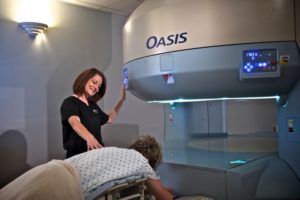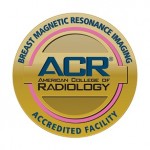 Guidelines from the American Cancer Society do include screening MRI with mammography for certain high-risk women. This option should be considered for the following:
Guidelines from the American Cancer Society do include screening MRI with mammography for certain high-risk women. This option should be considered for the following:
- Women with BRCA1 or BRCA2 mutation (BRCA1 is a gene, which, when altered, indicates an inherited susceptibility to cancer. BRCA2 is a gene, which, when altered, indicates an inherited susceptibility to breast and/or ovarian cancer.)
- Women with a first-degree relative (mother, sister, and/or daughter) with a BRCA1 or BRCA2 mutation, if they have not yet been tested for the mutation
- Women with a 20% to 25% or greater lifetime risk of breast cancer, based on 1 of several accepted risk assessment tools that look at family history and other factors
- Women who have had radiation treatment to the chest between the ages of 10 and 30, such as for treatment of Hodgkin disease
- Women with the genetic disorders Li-Fraumeni syndrome, Cowden syndrome, or Bannayan-Riley-Ruvalcaba syndrome; or those who have a first degree relative with the syndrome
Some common uses for breast MRI include:
- Further evaluation of abnormalities detected by mammography.
- Finding early breast cancers not detected by other tests, especially in women at high risk and women with dense breast tissue.
- Examination for cancer in women who have implants or scar tissue that might produce an inaccurate result from a mammogram This test can also be helpful for women with lumpectomy scars to check for any changes.
- Detecting small abnormalities not seen with mammography or ultrasound (for example, MRI has been useful for women who have breast cancer cells present in an underarm lymph node, but do not have a lump that can be felt or can be viewed on diagnostic studies).
- Assess for leakage from a silicone gel implant.
- Evaluate the size and precise location of breast cancer lesions, including the possibility that more than one area of the breast may be involved (this is helpful for cancers that spread and involve more than one area)
- Determining whether lumpectomy or mastectomy would be more effective.
- Detecting changes in the other breast that has not been newly diagnosed with breast cancer (There is an approximately 10 percent chance that women with breast cancer will develop cancer in the opposite breast. A recent study indicates that breast MRI can detect cancer in the opposite breast that may be missed at the time of the first breast cancer diagnosis.)
- Detection of the spread of breast cancer into the chest wall, which may change treatment options.
- Detection of breast cancer recurrence or residual tumor after lumpectomy.
- Evaluation of a newly inverted nipple change.
 Breast MRI is performed at our Metairie – Veterans Memorial Boulevard and Covington – Highway 21 locations. We are accredited by the American College of Radiology in breast MRI, meeting or exceeding the standards set for quality, safety, reporting, technology and expertise.
Breast MRI is performed at our Metairie – Veterans Memorial Boulevard and Covington – Highway 21 locations. We are accredited by the American College of Radiology in breast MRI, meeting or exceeding the standards set for quality, safety, reporting, technology and expertise.
Call 504-883-5999 or 985-641-2390 for your very own DIS patient experience. At DIS, we do not compromise quality for cost. Our exams are completed in a warm, relaxed and friendly environment, free of busy hospital corridors, crowded parking garages, and less-than-clean elevators and stairways.
The bonus: DIS offers average exam fees that are substantially less than what is charged by local hospitals and their imaging centers. DIS charges one price for all services. Hospitals? They usually tack on fees for their radiology services and use of the facility.
So, why pay more for the same exam? It’s your health care. It’s your money.

